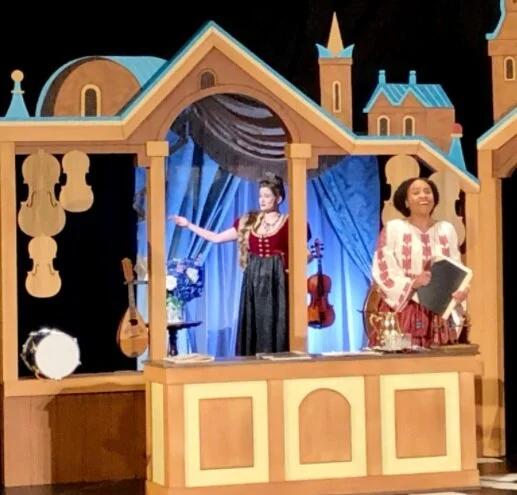From folk art to architecture, the multilayered inspiration for The Music Shop's whimsical sets
Scenic designer Omanie Elias follows a “winding road” for a striking Vancouver Opera filmed production
The sets for Young Artists Program’s The Music Shop features stylized folk-art touches against a striking black background. Photo by Autumn Coppaway
Vancouver Opera streams The Music Shop starting March 13 at 7:30 pm
ARTIST AND SCENIC designer Omanie Elias describes creating a visual world for a show as a “winding road”: “You set off in one direction, and all sorts of factors come in,” she tells Stir.
That’s certainly the case for the stylized, Russian-storybook sets and costumes she’s created for Vancouver Opera’s new online presentation of The Music Shop, by the members of its Young Artists Program.
Conceiving the scenery for the Canadian premiere of American composer Richard Wargo’s comedic opera with director Dana Fradkin has taken Elias from the streets of Prague, to post-revolution-Russiafolk art, to the modern-day considerations of a multicamera shoot during COVID times.
The farcical story, set in 19th-century Russia, centres on Ivan, who arrives at the titular store on an urgent mission: he has to buy specific sheet music for a song that his wife must sing for the Prince. The only problem? He’s forgotten the title. Cue a mad scramble through a small mountain of paper and hallucinations of the enraged, domineering wife that will greet him at home if he returns empty-handed.
One of the first things that came to mind for Elias was the memory of a photograph she had taken on a visit to Prague. “On the last day I found this little music store, and they had all these pieces of stringed instruments—just the backs and fronts in different woods—hanging there at different levels,” says the artist, who also designed the costumes for the opera.
That inspiration plays out cutout-effect violins and cellos that decorate the music emporium in the production.
As Elias dove into the libretto and the history of the time, she wanted to evoke the feeling of Imperial Russia. “I wanted that feeling of decadence but also the playfulness that comes with the opera itself,” she explains.
Beyond the shop you can see the whimsically suggested blue rooftops of 19th-century Russian architecture, all set against a distinct black background. It’s a colour combination that Elias found in the folk art that was popular just after Imperial times—but that perfectly suited the needs of the black-draped and -floored rehearsal hall where the production would be shot. As opposed to the religious-icon paintings that predated the style, these works were based on literature, fables, and real life.
Photo by Autumn Coppaway
“They were brightly coloured paintings on black backgrounds, often on utilitarian items like trays and boxes,” Elias explains. “Not only were they very beautiful but they were also stylized with the black background.”
Other inspiration came from the vivid hues of children’s illustrations and toys, she adds. In a further layer to the design, look for the way it’s laid out like a triptych—a nod to the format of old Russian religious-icon painting.
But the sets and costumes’ looks had to function far beyond aesthetics. Having the work filmed by three cameras, sometimes in closeup, required an attention to detail that set designers don’t normally have to worry about.
The Music Shop also brings more than opera’s usual amount of roughhousing and other physical comedy.
“You have to consider with the costumes that things are loose and don’t hamper the artists,” explains Elias. “There’s a lot of crawling on the floor and kneeling on the floor. They had to have kneepads hidden under the costumes—especially the two men, who have some very gymnastic moments.”
In an added, oh-so-2021 necessity, Elias had to add pockets to every outfit so the cast could carry hand sanitizer to disinfect anything they’d touch.
In fact, COVID considerations have to be integrated invisibly into every aspect of stage design these days: none of the four performers could stand within three metres of each other, Elias says.
Still, the restriction haven’t taken away from the pleasure the artist has gotten out of the project. It’s been a welcome bit of light in a year that started, last March, with Elias having to stop painting sets for a different production, putting them away into storage for a later date. The past year also brought the loss of her New West artist studio to redevelopment—a place where Elias had been creating her own artwork in a range of media, from charcoal and water colour to stained glass and textiles.
For Elias, and the entire opera crew, it's good to be creating again. “I think it's one of my favourites of my career,” she says of The Music Shop set, then adds, “And the whole production too, with the Young Artists: it’s just been a joy to work with them.”















